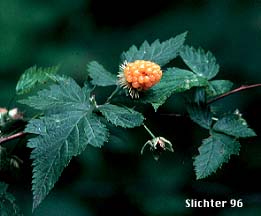 The photo at right shows the
salmon-colored fruit of the salmonberry. The fruit color varies from salmon-colored
to a bright, blood red color.
The photo at right shows the
salmon-colored fruit of the salmonberry. The fruit color varies from salmon-colored
to a bright, blood red color.
Salmonberry is a deciduous shrub from 1-4 meter in height. It has erect or arching stems. Stems which grow in the open tend to be unbranched, while those in shade are more likely to be branched. The stems may be smooth (old growth) or densely prickly (new growth). The winter twigs are a distinctive golden-brown to rust-red color. Salmonberry is strongly rhizomatous, so one needs to watch its growth carefully if using it in a moist woodland garden so that it doesn't encroach upon other prized plants!
The leaves alternate along the stems. They are ternately compound, usually with 3 triangular leaflets, although 5 may occasionally be found. The tips of the leaflets are often sharply pointed. The terminal leaf is largest, ranging from 4-9 cm in length. All the leaflets may be unequally lobed, and all have doubly-toothed margins.
1-2 flowers are found on short, leafy side branches. The 5 lobes of the calyx are spreading, ovate-lanceolate in shape and from 9-15 mm in length. The 5 petals are red to reddish-purple. They are showy, twice as long as the sepals, and obovate-elliptic in shape. There are 75-100 stamens and numerous pistils. The fruit is raspberry-like with a reddish to salmon coloration.
The fruits have been an important, traditional food source for Native Americans, one which is still collected today. The fruits are readily eaten by a variety of birds and mammals. The early blooming flowers are an important food source for insects and hummingbirds. The twigs, stems, and leaves are all grazed by browsers such as deer. Salmonberry thickets provide important escape and nesting habitat for many birds. Salmonberry is also a useful shrub for landscape use in wetland areas.
Salmonberry may be found in moist lowland forests and in wetlands or along streams. It may be found as individual plants or as part of dense thickets.
Salmonberry may be found from Alaska south to northwestern California. It is most common between the Pacific coast and the Cascade crest. It rarely seen east of the Cascades.
In the Columbia River Gorge, it may be found between the elevations of 100'-4500' from the western end of the gorge to as far east as Dog, Mt.